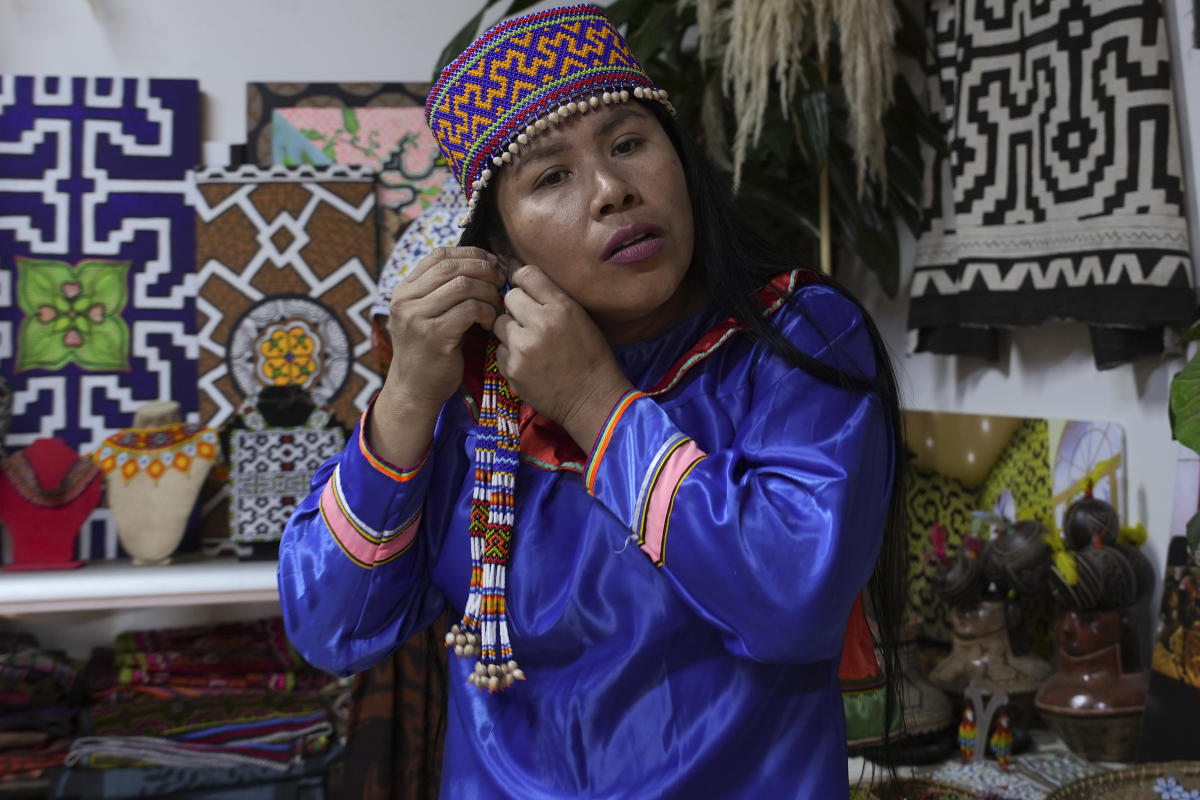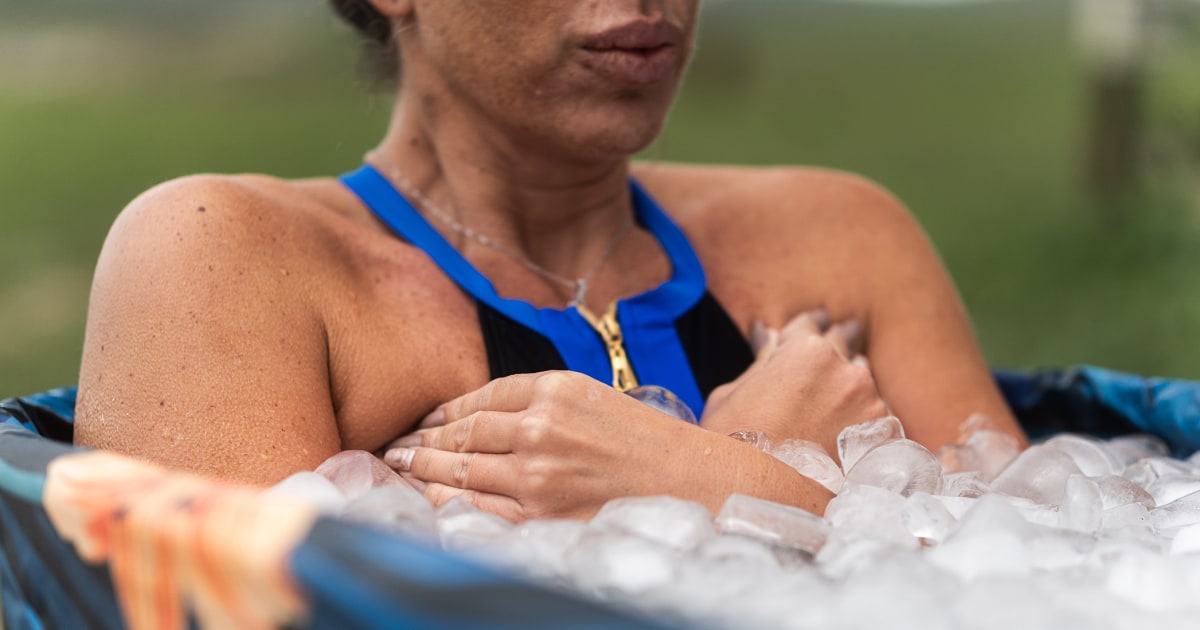LIMA, Peru (AP) — Sadith Silvano’s crafts come from ancient songs. Brush in hand, eyes focused on the fabric, the Peruvian woman paints while she sings. And through her voice her ancestors speak.
“When we paint, we listen to the inspiration that comes from the music and we connect with nature, with our elders,” says Silvano, 36, from her home and workshop in Lima, Peru, where she moved twenty years ago from Paoyhan, a Shipibo-Konibo Indigenous community nestled in the Amazon.
“These pieces are sacred,” she added. “We bless our work with the energy of our songs.”
Trusted news and daily treats, straight to your inbox
See for yourself: The Yodel is the source for daily news, entertainment and feel-good stories.
According to official figures, almost 33,000 Shipibo-Konibo people live in Peru.
Many settled around the Uyacali River and moved to urban areas such as Cantagallo, the Lima neighborhood where Silvano lives.
Hand-painted textiles, such as the textiles she makes, have slowly gained recognition. Known as ‘kené’, they were declared part of the ‘Cultural Heritage of the Nation’ by the Peruvian government in 2008.
Every kené is unique, say Shipibo craftsmen. Each pattern speaks to a woman’s community, her worldview and beliefs.
“Every design tells a story,” says Silvano, dressed in traditional clothing and crowned with a beaded garment. “It is a way for a Shipibo woman to distinguish herself.”
Her craft is passed on from one generation to the next. Because wisdom is rooted in nature, the knowledge left by the elders connects the younger generations to their land.
Paoyhan, where Silvano was born, is a flight and a 12-hour boat ride from Lima.
In her hometown, locals rarely speak languages other than Shipibo. Doors and windows have no locks and people eat from Mother Nature.
Adela Sampayo, a 48-year-old healer born in Masisea, not far from Paoyhan, moved to Cantagallo in 2000, but says all her skills come from the Amazon.
“Since I was a little girl, my mother treated me with traditional medicines,” said Sampayo, sitting in the lotus position in the home where she provides ayahuasca and other remedies to those with injured bodies or souls.
“She gave me plants to get stronger, to keep me from getting sick, to be brave,” Sampayo said. “That’s how the energy of the plants started to grow in me.”
She also conveys her worldview through her textiles. Although she doesn’t paint, she embroiders, and every thread tells a story of home.
“Every plant has a spirit,” said the healer, pointing to the leaves embroidered into the fabric. “And medicinal plants come from God.”
The plants painted by Silvano also have meaning. One of them represents pure love. Another symbolizes a wise man. One more: a snake.
“The anaconda is special to us,” Silvano said. “It is our protector, like a god who takes care of us and provides food and water.”
In ancient times, she said, her people believed that the sun was their father and the anacondas were their guardians. Colonization brought a new religion – Catholicism – and their indigenous worldview became diluted.
“Today we have different religions,” Silvano said. “Catholic, evangelical, but we also respect our other beliefs.”
After her father brought her to Lima in hopes of a better future, she spent years longing for her mountains, her clear skies, and her time alone in the jungle. Life in Paoyhan wasn’t exactly easy, but from a young age she learned how to stay strong.
In the 1990s, communities in the Amazon were hit by violence from the Shining Path insurgency and illegal logging. Poverty and sexism were also common, which is why many Shibipo women taught themselves how to deal with their anxiety through the heartfelt music they sing.
“When we encounter difficult times, we overcome them with our therapy: designing, painting, singing,” Silvano said. “We have a song that is melodious and heals our souls, and another that is inspiring and brings us joy.”
Few Shipibo girls are encouraged to study or fend for themselves, Silvano said. Instead, they are taught to wait for a husband. And once they are married, they must be able to tolerate any abuse, cheating or inconvenience they encounter.
‘Even though we suffer, people say to us: take it, he is the father of your children. Take it, he’s your husband,” Silvano said. ‘But deep inside we are wounded. So what do we do? We sing.”
The lesson is taught from mothers to daughters: if you are in pain at home, take your cloth, your brush and go away. Go far away, alone, and sit down. Connect with your kené and paint. And while you paint, sing.
“That’s our healing,” Silvano said. “Through our songs, our kenés, we are free.”
Delia Pizarro makes jewelry in the workshop where she now works and raises her two children alone. She also sings while making birds from colorful beads.
“I didn’t used to sing,” Pizarro said. “I was very submissive and didn’t like to talk, but Olin, Sadith’s sister, said to me, ‘You can do this.’ So now I’m a single mother, but I can go wherever I want. I know how to defend myself and fight. I feel appreciated.”
The figures in the products they manufacture for sale are varied. In addition to anacondas, they also like to depict jaguars, which represent women, and herons, which were cherished by the elders.
It can take up to a month and a half before a Shipibo textile is ready. The materials needed to make it – the fabric, the natural pigments – are sourced from the Amazon.
The black color that Silvano uses is extracted from a bark tree that grows in Paoyhan. The cloth is made from local cotton. The mud used to set the colors comes from the Uyacali River.
“I like it when a foreigner comes and leaves with something from my community,” Silvano said, touching one of her newly dyed fabrics to bless it for a quick sale.
She said the crafts of her people were little known when she and her father first arrived in Lima 20 years ago. But she says things have changed now.
In Cantagallo, where about 500 Shipibo families have settled, many earn a living by selling their crafts.
“My art has given me strength and is my faithful companion,” Silvano said. “Thanks to my mother, my grandmother and my sisters, I have an acquaintance with whom I have been able to open doors.”
“Here is the energy of our children, our ancestral world and our community,” she added, her textiles still between her hands. “Here is the inspiration from our songs.”
____
Associated Press religion reporting is supported by the AP’s partnership with The Conversation US, with funding from Lilly Endowment Inc. The AP is solely responsible for this content.






